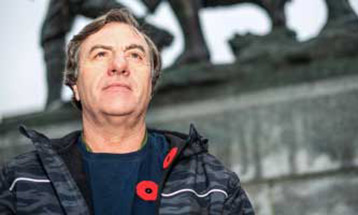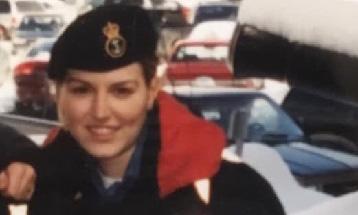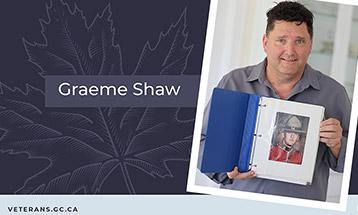
Shawn L. Patterson, MMM, CD
Shawn joined the CAF as Mobile Support Operator, 1980.
| Postings |
|---|
| CFB Gagetown 1981-87 |
| CFB Lahr, Germany 1987-91 (4 Service Battalion) |
| CFB Gagetown 1991-95 CFB Halifax 1996–2001 |
| Rwanda 1995–96 |
| CFB Halifax 1996–2001 |
| CFB Edmonton 2001–04 (1 Service Battalion) |
| CFB Kingston 2004–07: Deployed to Afghanistan as Regimental Sergeant Major, 2005, and to Lebanon (Op Lion) as Squadron Sergeant Major, 2006 |
| CFB Petawawa 2007–09 (2 Service Battalion Transport Company Sergeant Major) |
| Afghanistan 2009–10 (National Support Element Regimental Sergeant Major) |
| CFB Petawawa 2011–14 (Area Judge Advocate General Chief Warrant Officer) |
| CFB Detachment Charlottetown 2014–17 (Veterans Affairs Canada Chief Warrant Officer) |
| Veterans Affairs Canada, Charlottetown 2017–2019 (Supervisor of Nurse Adjudicators) |
Chief Warrant Officer (Retired) Shawn Patterson, MMM, CD, served 37 years with the Canadian Armed Forces. An outspoken Veterans' advocate, Shawn shares his insights on Veteran identity and the challenges and rewards of transition to life after service.
I took off my diaper and joined the Forces as a trucker at 17. I loved being a soldier and I was really good at it. But very early in my life, I realized that there was more to life than being a soldier. I knew I would have to leave the Forces eventually, and that would make me a Veteran.
What does that mean? What is a Veteran? There are as many answers to that question as there are Veterans. First, you’re different from civilians. They weren’t in the military, so they never had to go through what you’ve gone through. Then you’re either an Army, Navy or Air Force Veteran. Traditionally we talk trash at each other. The Air Force live in hotels. The Navy sleep on ships and get three hots a day. The army, we live in the ground. Then you break it down into the different trades and branches. Combat arms will always figure that they had it tougher and faster than rear echelon guys like me. Then it’s about where you served. 'I'm a Bosnia Vet.' 'I'm Rwanda.' “I’m Afghanistan.” 'Well, me too but what unit?' 'You didn't see what I saw, so you don't know what you're talking about.'
Look, it doesn't matter what unit, battalion, regiment, branch you belong to. When push comes to shove, we’re one team. We rely on each other. It’s about interdependency. Combat arms can't fight unless logistics brings materials forward. We can't bring it forward unless the maintainers fix it.
That's what we all miss once we leave the Forces. We miss that interdependency. Regardless of what we did, we're all interconnected and reliant on each other to be a force of war.
We’re built that way
The Forces takes raw recruits, strips out the individualism and makes them part of a team. You and your buddies. I’ve got your back, you’ve got my back. No hesitation. Doesn't matter what trade, what branch. That's how it starts. Whether you’re in for five years or 35 years, service becomes the new normal, and that's why it's so hard for people to let go.
I heard one guy describe being released from the Forces as like being pushed off a cliff. Leaving the military can be scary, but the fact is that most members navigate transition without difficulty.
I talked to another guy who released after 21 years. He said, 'Didn't you find it weird to be out?' I said, 'I felt a bit awkward on my first day. It felt like I’d taken my body armor off. Because I was walking around town and all of a sudden I realized I looked like everybody else.
He said, 'I'm not ready to let go yet. I think I'm going to join the Reserves.' I said, 'Right on. Good for you. You’ve got a new purpose.'
Your identity is never defined by only one aspect of who you are. It's all you are to yourself and everyone who cares about you. Your identity is constantly shifting. Always will be.
The power of community
Maintaining a military connection can be important. I’m very fortunate to have buddies who retired three, four years ahead of me. I’m able to lean on their experiences—and I strongly recommend that any Veteran maintain a network like this. It’s that interdependency again.
When you release, the Forces doesn’t reverse that process of indoctrination that brought you on board. Nobody strips the military out of you. Nobody can. Part of me will always be a soldier and I’m proud of that. But I know it’s really important to build connections and interdependencies outside the Forces when you transition—at home, at work, in your neighbourhood, your town. I focused on my family.
For many folks, the military is the first family. I once used the 'When you married me, you married the Forces' line on my ex-wife. That did not go down well. And she was right. Family is a connection that has to be maintained. This is part of the social aspect of your overall well-being.
Veterans Affairs Canada talks a lot about well-being. That’s because it’s key to your successful transition to life after service. We usually think about well-being in terms of physical and mental health. It’s more than that. It’s about making sure you know that you have a purpose, which might include a meaningful second career. You might need training to adapt your expertise and successfully manage post-service life. Well-being is about the need for safe and affordable housing. Of course, it’s also about financial security and the important role of personal relationships and support from your community.
So what is a Veteran?
I know I haven’t really answered that question yet. I didn't think of myself as a Veteran until my second tour in Afghanistan because I always associated Veterans with war. Now I believe that the best way to define a Veteran is as a citizen who has volunteered to serve in the Canadian Armed Forces, given it 100 percent and been retired or released.
You know what else a Veteran is? He or she is a spouse, a parent, a grandparent, a sibling, a child, a friend, a colleague, a coach, a neighbour, a boss, a musician, a carpenter, a hunter, a gardener, a curler. Your identity is never defined by only one aspect of who you are. It’s all you are to yourself and everyone who cares about you. Your identity is constantly shifting. Always will be.
Maybe you’ll get a new job when you release. Spend more time with your family. Go back to school. Focus on your health. All these things will gradually shape your post-service identity.
Want to experience a successful transition and build the post-service identity that’s right for you?
Here’s my advice:
- Look at transition as a new mission
I understand completely about being very well looked after in the Forces, but everyone knows that ends. You’re the CO now. Step up and take responsibility to get what you need. Transition involves work, just like service. You need to have a plan. Organizations like Veterans Affairs Canada will work with you to create that plan. - Attend your SCAN seminar
This is one of the best ways to learn about transition while you’re still serving. These seminars cover a lot of information. Don't assume you’re the expert. Listen. Keep the handouts for reference. - Make sure your medical records are up to date
Document your injuries and illnesses, especially if they’re related to your service. This will ensure your post-service healthcare providers will have accurate information when you release. I busted up my right shoulder in service, but I made sure my records were in order and that improved the compensation process. - Sign up for My VAC Account
My VAC Account is the best way to do business with Veterans Affairs Canada. Create your own account to apply online for benefits and services, track your applications and connect with department staff by secure messaging. Sign up before you release. All you need is your service number. - Book a transition interview
Do it early. It’s part of the planning you have to do. The interview gives you the chance to work with Veterans Affairs Canada to identify benefits and services you may qualify for. It’s a good idea to bring along a family member. Your family member can help tell your story, and it never hurts to have a second set of ears in the room. - Be open to the support that is available
We in the military aren’t always that good about accepting help. We think we can do it all. We can’t. Take the help when you need it, especially if you’re ill or injured. - Never forget
We are all so much more than what has happened to us. Transition to life after service is the chance to find out what that is.
Date published: 2018-10-10
Sources: Shawn Patterson - MMM, CD




